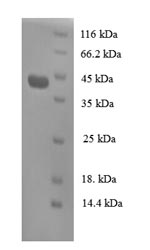Presenting our premium Recombinant Human REG3A protein, also known as Regenerating islet-derived protein 3-alpha (REG-3-alpha), a crucial component for advancing research in the field of immunology. REG3A is a C-type lectin protein that displays antibacterial activity and plays a vital role in the innate immune response, particularly in the pancreas and gastrointestinal tract.
Our Recombinant Human REG3A protein is expressed in E.coli, ensuring the full length of the mature protein (27-175aa) is obtained. The N-terminal GST-tag allows for efficient purification while preserving the protein's native structure and function. With a purity greater than 90% as determined by SDS-PAGE, our REG3A protein guarantees consistent and reliable results in your research applications. Available in both liquid and lyophilized powder forms, our Recombinant Human REG3A protein is ready to support your scientific endeavors.






